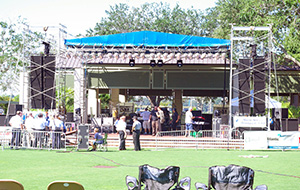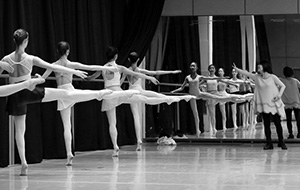 Choreographer and dancer Christopher Marney, perhaps best known for his work as a principal dancer with Matthew Bourne’s New Adventures, was recently announced as the new Artistic Director of Ballet Central. Functioning as the touring company of Central School of Ballet’s third year students, Ballet Central will now be lead by Marney as he ultimately guides them towards industry employment as graduates.
Choreographer and dancer Christopher Marney, perhaps best known for his work as a principal dancer with Matthew Bourne’s New Adventures, was recently announced as the new Artistic Director of Ballet Central. Functioning as the touring company of Central School of Ballet’s third year students, Ballet Central will now be lead by Marney as he ultimately guides them towards industry employment as graduates.
Marney himself is an alumnus of Central School of Ballet, taught by the late founder of the school Christopher Gable. As a great influencer on Marney’s subsequent professional life, this new appointment will see Marney ensure that Gable’s ethos and legacy will live on in future generations of Central students. Marney will take up the post from September, and will continue to undertake freelance work as a performer/choreographer, anticipating the forging of collaborations between Central School of Ballet and industry professionals.
Marney is currently performing in the world tour of Matthew Bourne’s Sleeping Beauty (for which he was also the Associate Choreographer); recent work also includes choreographing for McQueen The Play in London’s West End, and for Ballet Black at the Barbican. Prior to this, Marney’s comprehensive performance career includes work with companies such as BalletBoyz, Michael Clark and Gothenburg Ballet, in addition to receiving Critics Circle nominations at the National Dance Awards.
Following the summer, this creative individual will be shaping the futures of the young artists at Central School of Ballet. Ballet Central will benefit greatly from Marney’s expertise and artistic vision, having already enriched the many companies he has previously been part of. His professionalism, work ethic and unparalleled understanding of theatre and performance will be at the heart of his nurturing of these students as they transition into the competitive dance industry.
Category: Uncategorised
Working with the Rockettes
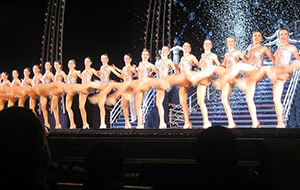 Mia Michaels, well-known contemporary choreographer, is living it large. Having launched her own company, she has been a three-time Emmy Award winner as a result of her work on “So You Think You Can Dance”, and has also choreographed a hit Broadway musical. Michaels is now set to step it up a gear and is preparing to start work with the legendary Rockettes in New York.
Mia Michaels, well-known contemporary choreographer, is living it large. Having launched her own company, she has been a three-time Emmy Award winner as a result of her work on “So You Think You Can Dance”, and has also choreographed a hit Broadway musical. Michaels is now set to step it up a gear and is preparing to start work with the legendary Rockettes in New York.
Michaels will make her debut as the director and choreographer of the New York Spectacular, starring the Radio City Rockettes, which is a revamped version of last year’s New York Spring Spectacular. She will be working with the company on the new show, gearing up to present it at Radio City Music Hall from 15 June–7 August. Originally Michaels was brought in to choreograph the opening number of the Spring Spectacular, and is now directing the entire show.
Having strived to direct for a long time, Michaels is now getting her chance with this challenging first project. The new show depicts a magical journey through New York City, told through the eyes of a child. Michaels will be introducing a group of male dancers to the mix, for lots of dance work and original music. Whilst the movement will still be typical classic-Rockette, there will also be added contemporary strands to challenge the dancers physically and technically.
The Rockettes have been in existence for more than 85 years, but the challenge of Mia Michaels is a first. Michaels is aspiring to create a New York spectacle – including the inevitable kick lines – in breathing new life into the company. The Rockettes brand is iconic, so pairing it with the work of Michaels really is a recipe for success, retaining the iconic movement with fresh tweaks. Whilst the challenge of directing may be initially overwhelming, the end result is set to be spectacular.
Festivals of dance
Garuda – the new Pilates
 Whilst Pilates has been held in high regard as complementary to dance, there is a new kid on the block. Garuda is complementary to Pilates, and therefore to dance training, using the principles of Pilates but taking the ideology one step further. Many ballet companies and vocational schools employ Pilates as part of dancers’ training, useful for injury prevention, rehabilitation and conditioning: Garuda could now become the popular name.
Whilst Pilates has been held in high regard as complementary to dance, there is a new kid on the block. Garuda is complementary to Pilates, and therefore to dance training, using the principles of Pilates but taking the ideology one step further. Many ballet companies and vocational schools employ Pilates as part of dancers’ training, useful for injury prevention, rehabilitation and conditioning: Garuda could now become the popular name.
Garuda too can be performed on machines or through mat-based exercises, focusing on strength, flexibility, coordination, endurance and increasing range of motion for muscle and joints. The method was developed by James D’Silva, drawing on his experience in training in classical and contemporary dance in the UK before working as a dancer, choreographer and teacher throughout Europe and the USA. From his Indian roots, he went on to open a Pilates studio and develop Garuda as a result of using Pilates, yoga and body conditioning as part of his training routine. Ideas from Gyrotonic, Feldenkrais, Tai Chi and Alexander Technique also developed Garuda, informing his body/mind connection.
The philosophy behind Garuda focuses on breath, rhythm, flow and the idea of relaxation within movement, in order to also strengthen and tone muscles, improve structural fitness and promote a meditative sense of calm. It aims to support the recovering body in finding its athletic form, with the results displaying a stronger, leaner body, improved posture and ease of movement in everyday life. Aside from providing a cardiovascular workout, it also focuses the mind in combining relaxation with exercise.
Garuda incorporates mat-work sequences, barre and a versatile exercise apparatus to contribute to rhythm and flow, promoting a new and improved way to isolate muscle groups. The specialised movements are broken down into motions beneficial for those in dance or undergoing a personalised rehabilitation programme, with a focus on transitions in addition to mindfulness, awareness and introspection. Practitioners constantly work to strengthen the joints, with a focus on alignment and precision of movement. For dancers specifically, it can also be used to understand where to activate for movement, benefit from multi-directional stretch, as well as for stability and strength.
Alvin Ailey American Dance Theater UK Tour
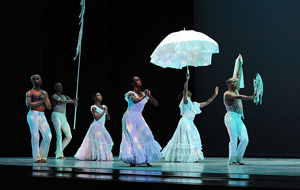 Dance Consortium recently announced its Alvin Ailey American Dance Theater UK Tour for 2016: in the UK this will begin with a two-week season at Sadler’s Wells, London. The tour will then journey to Plymouth, Birmingham, Bradford, Nottingham, Cardiff, Salford Quays, Southampton, Canterbury and Edinburgh, and will include five premieres. The UK premieres consist of works by Robert Battle, Artistic Director, and choreographers Rennie Harris, Ronald K. Brown and Aszure Barton. Two company premieres are a pas de deux by Christopher Wheeldon, with an additional piece by Paul Taylor.
Dance Consortium recently announced its Alvin Ailey American Dance Theater UK Tour for 2016: in the UK this will begin with a two-week season at Sadler’s Wells, London. The tour will then journey to Plymouth, Birmingham, Bradford, Nottingham, Cardiff, Salford Quays, Southampton, Canterbury and Edinburgh, and will include five premieres. The UK premieres consist of works by Robert Battle, Artistic Director, and choreographers Rennie Harris, Ronald K. Brown and Aszure Barton. Two company premieres are a pas de deux by Christopher Wheeldon, with an additional piece by Paul Taylor.
No Alvin Ailey American Dance Theater appearance would be complete without its signature masterpiece Revelations, performed in addition to other company classics by company founder Alvin Ailey, Cry and Night Creature. The appearance of the company in the UK is following a six year absence, it’s return presented again by Dance Consortium. The diverse repertoire of works and premieres means audiences will be both entertained and fulfilled.
Founded in 1958, Alvin Ailey American Dance Theater is recognised as one of the world’s most popular dance companies. Under the leadership of Battle, Ailey’s performances celebrate the human spirit through the African-American cultural experience and the American modern dance tradition. In almost six decades, Ailey’s artists have performed for over 25 million people in 71 countries on six continents, and continue to wow audiences and critics around the world. The 2016 autumn tour will mark the fourth time Ailey is presented by Dance Consortium, and begins on 6 September with its four-programme season at Sadler’s Wells. It concludes at Festival Theatre, Edinburgh on 19 October.
Additionally, in London and Southampton, Ailey’s Mini Matinee is the perfect introduction to the company’s repertoire. Aimed at family audiences, Mini Matinees are 60 minutes long and include short introductions before each work, as well as a post-performance Q&A with members of the company.
London-bound: An American in Paris
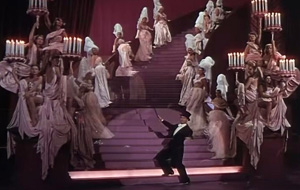 London is set to welcome the classic musical An American in Paris, Broadway’s Tony Award-winning new musical at the Dominion Theatre from March 2017. With tickets now on sale, the musical tells the story of Jerry Mulligan, an American GI striving to make it as a painter in a city bursting with hope and possibility. Following a chance encounter with a young dancer named Lise, the streets of Paris become the backdrop to a ‘modern romance of art, friendship and love in the aftermath of war’.
London is set to welcome the classic musical An American in Paris, Broadway’s Tony Award-winning new musical at the Dominion Theatre from March 2017. With tickets now on sale, the musical tells the story of Jerry Mulligan, an American GI striving to make it as a painter in a city bursting with hope and possibility. Following a chance encounter with a young dancer named Lise, the streets of Paris become the backdrop to a ‘modern romance of art, friendship and love in the aftermath of war’.
An American in Paris is inspired by the Oscar® winning film of the same name, and features the timeless music and lyrics of George Gershwin and Ira Gershwin. It will head to London and burst onto the West End stage for the first time next year, with the official opening night on 21 March 2017 (with preview performances from 4 March). An American in Paris features many of George and Ira Gershwin’s most iconic songs including I Got Rhythm, ‘S Wonderful, and They Can’t Take That Away From Me.
The multi award-winning musical will again be choreographed by Christopher Wheeldon, who will also be directing An American in Paris. The internationally renowned, British-born Wheeldon, recipient of the Tony Award 2015: Best Choreographer for this production, is an Artistic Associate of the Royal Ballet. Wheeldon received an OBE in the 2016 New Year’s Honours, highlighting his work in the industry.
Wheeldon’s reinvention of the MGM film, which originally starred Gene Kelly and Leslie Caron, premiered in 2014 at the Théâtre du Châtelet in Paris to ecstatic reviews before transferring to The Palace Theatre on Broadway, where it is now in its second hit year, becoming the most awarded musical of the 2015/16 season. Fresh from originating their roles on Broadway, Robert Fairchild (New York City Ballet Principal dancer) will play Jerry Mulligan and Leanne Cope (British Royal Ballet dancer) will play Lise Dassin. The pair will be making their West End debuts, and will lead a company of over 50 other actors, dancers and musicians.
Bio-banding for dance
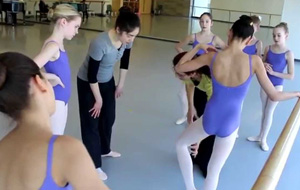 A recent study in dance injury has suggested that ‘bio-banding’ could reduce the risk of injury for ballet dancers. Bio-banding refers to grouping dancers by physical maturity – rather than age – in classes. This could better suit late-maturing girls in coping with intense training, rather than apply a blanket-style, objective teaching to all students without considering their individual development.
A recent study in dance injury has suggested that ‘bio-banding’ could reduce the risk of injury for ballet dancers. Bio-banding refers to grouping dancers by physical maturity – rather than age – in classes. This could better suit late-maturing girls in coping with intense training, rather than apply a blanket-style, objective teaching to all students without considering their individual development.
The study, published in the Journal of Adolescence, highlighted how time differences in maturing have important implications for talent identification and development, as well as personal self-esteem. This has specific implications for ballet and dance training, where these issues can be more apparent. It could be more beneficial, therefore, to group young dancers by their developmental rather than chronological age in order to lower their risk of injury, and provide a more sensitive and specific training method for them.
Bio-banding is growing in prominence for other sports, and the research done by the UK’s Bath and Bristol universities indicates that the current practices for grouping and evaluating young dancers could be counterproductive. The study has so far focused purely on girls, essentially because girls of the same chronological age can vary greatly biologically, with some maturing in advance or delay of others. Those maturing later are potentially placed at a disadvantage in class, during important phases of their development. A dance teacher’s general role can be paramount for a young dancer, so their ability to manage maturation in dancers could then positively affect the girls’ self-esteem and confidence.
Applying bio-banding elements to dance could improve the experiences of dancers, reduce injury risks and also ensure talent is not wasted by promoting a positive learning environment. Currently dancers in vocational training are grouped by age and can begin full-time training for up to six days a week from as young as 11 years old. Here they would be provided with the most developmentally appropriate learning contexts, and would not be put under undue stress at the wrong points in their development.
Collaborative partnership for three theatres
 Sadler’s Wells, The Lowry and Birmingham Hippodrome theatres have formed a collaborative producing partnership, supported by funding from Arts Council England’s Ambition for Excellence fund. This is in order to develop and deliver an ambitious programme of high-quality large-scale dance. Named The Movement, the collaboration is set to be a dynamic partnership between three of the country’s leading dance venues.
Sadler’s Wells, The Lowry and Birmingham Hippodrome theatres have formed a collaborative producing partnership, supported by funding from Arts Council England’s Ambition for Excellence fund. This is in order to develop and deliver an ambitious programme of high-quality large-scale dance. Named The Movement, the collaboration is set to be a dynamic partnership between three of the country’s leading dance venues.
Through a two-year pilot initiative for the theatres – that has been awarded a grant of £749,948 – they will strive to nurture dance talent as like-minded partners who share a commitment to growing new audiences together. Reaching and developing new audiences for dance through a programme of work will be co-produced by the three venues, with the line up including Company Wayne McGregor, Birmingham Royal Ballet, BBC Young Dancer finalist Vidya Patel, world tango champions German Cornejo and Gisela Galeassi, hip hop company Pockemon Crew, and Sidi Larbi Cherkaoui’s Faun.
The Movement will launch at Birmingham Hippodrome on 17 and 18 May with Dance: Sampled, the first production to be presented via the partnership and as part of the International Dance Festival Birmingham 2016. Dance: Sampled is inspired by the popular Sampled format Sadler’s Wells introduced, which offers audiences a taster selection of different dance styles all in one programme. The production will then run for two nights at The Lowry in February 2017. The theatres will work closely to commission and stage dance together, helping to support talent and inspire large audiences across the UK.
Outside of London, Birmingham Hippodrome is an independent, not-for-profit, registered charity welcoming an average of 500,000 visits annually making it the most popular single auditorium in the UK. The Lowry is the most visited cultural destination in the North West. It plays host to one of the one of the UK’s most vibrant and diverse theatre programmes, as well as a visual arts programme.
Daniel Davidson – Scotland to Sadler’s Wells
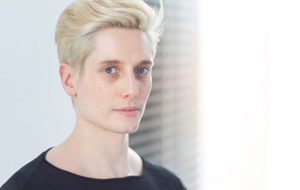 Daniel Davidson, born in Edinburgh, UK, trained at both The Dance School of Scotland and Millennium Dance 2000. He joined dance company Rambert in August 2014 after 8 years with Scottish Ballet, and since joining he has created roles in works by Alexander Whitley and Didy Veldman as well as performing The Rooster Man in Bruce’s Rooster. He has also danced in works by Jeyasingh, Brandstrup, Baldwin, Page and Cunningham.
Daniel Davidson, born in Edinburgh, UK, trained at both The Dance School of Scotland and Millennium Dance 2000. He joined dance company Rambert in August 2014 after 8 years with Scottish Ballet, and since joining he has created roles in works by Alexander Whitley and Didy Veldman as well as performing The Rooster Man in Bruce’s Rooster. He has also danced in works by Jeyasingh, Brandstrup, Baldwin, Page and Cunningham.
Whilst at Scottish Ballet, Daniel created principal roles such as Petrushka in Petrushka at the Edinburgh International Festival and Don José in Richard Alston’s Carmen. He has originated works for choreographers such as Page, Alston, Caniparoli, Lawrence, Pastor and Petronio. Additionally, he performed in works by Forsythe, Ashton, MacMillan, Balanchine, Bourne, Bruce, Tharp, Brown and Elo as well as Mercutio in Pastor’s Romeo and Juliet.
Photo credit © Benedict Johnson
Have always wanted to be on stage?
My mum took me along to my first dance lesson in our local church when I was five and I loved it. I think I was around ten years old when I knew it was what I wanted to do for a living.
Where did you train, and what was it like?
I trained at The Dance School of Scotland… a boarding school in Glasgow where I trained in ballet and did my school studies alongside. After spending six years there, I moved to London where I trained at Millennium Dance 2000. My college was predominantly musical theatre based. As well as contemporary dance, I studied singing, acting, tap and jazz.
Describe a day in your life now.
I take class every morning for an hour and a half. Our classes alternate between ballet and contemporary so we can train equally in both. After class, we rehearse for two hours before lunch and for three hours after finishing at 6pm weekdays and 2pm on Saturdays. We rehearse pieces that we will be performing on our tours around the UK. Right now we are rehearsing three works for our performances at Sadler’s Wells in May.
What are you looking forward to most about the Sadler’s Wells Murder, Mystery and a Party programme?
I’m looking forward to premiering our new piece Tomorrow by Lucy Guerin. We’ve been working hard on it in the studio for around four weeks now. It’s been a very different kind of process than usual for us and I’m looking forward to hearing some feedback from the audience.
What are rehearsals like?
Rehearsal experiences vary depending on whether we’re rehearsing a new creation or an existing work. Right now I’m rehearsing one piece I’ve already danced, one existing work that I’ve not yet performed and one new creation. Each process is very different but equally rewarding. I would say that I enjoy being involved in new creations the most… I love the process of creating and collaborating with different choreographers.
Do you have any pre-show rituals?
Not really. I like to have a shower, put on my make up and have a stretch on stage before curtain up. Some dancers have a set routine and they’re slightly superstitious about their preparation but I’m not. I like to vary how I prepare.
What has been the defining moment of your career?
Performing the role of The Rooster Man in Christopher Bruce’s Rooster to a full house at Sadler’s Wells. It was an honour to dance such an iconic work. Definite career highlight.
What has been the most challenging?
Whilst with Scottish Ballet I danced many works by our director Ashley Page. His version of Sleeping Beauty was very hard and a wonderful challenge for a dancer. I danced the Bluebird… That was the most challenging of all roles for me. It was tricky, hard partnering, required a lot of stamina… Brilliant fun though!
What’s the most rewarding thing about dance?
The most rewarding thing is the performance. All of the hard work and preparation is absolutely worth it when you hear the audience’s applause and appreciation.
What’s the worst thing?
I wouldn’t say it’s the ‘worst’ thing but the hardest thing about dancing is the toll it takes on my body. Long hours can be tough too…
What is your advice to an aspiring dancer?
Work hard. Stick at it. Some days will be tough but some days will be so rewarding and fulfilling. Also, your taste will change… Don’t be afraid to keep trying new things.
Daniel Davidson will be performing at Sadler’s Wells from 10-14 May, as part of Rambert’s Murder Mystery and a Party. To find out more and to book tickets: http://www.sadlerswells.com/whats-on/2016/rambert-a-linha-curva-and-other-works/
The George Balanchine YouTube channel
 The George Balanchine Foundation has announced the launch of its official YouTube channel, launching with content from its Video Archives Collection. The Foundation is adamant that it is important to share the late choreographer’s work, meaning the Foundation will begin by posting nearly 50 video interviews from the Collection. As digital media continues to expand, the general public will have unprecedented access to this valuable source.
The George Balanchine Foundation has announced the launch of its official YouTube channel, launching with content from its Video Archives Collection. The Foundation is adamant that it is important to share the late choreographer’s work, meaning the Foundation will begin by posting nearly 50 video interviews from the Collection. As digital media continues to expand, the general public will have unprecedented access to this valuable source.
As a not-for-profit corporation founded in 1983, the mission of the Foundation is to create programmes that educate the public, and further Balanchine’s work and aesthetic in order to continue his high standards of excellence in dance. Featured in the films are dancers Balanchine created for, or taught his ballets to, who worked to coach today’s dancers in these particular roles.
The George Balanchine Foundation’s Video Archive Collection was designed to document Balanchine’s work as closely as possible, in detailing his original intent for his work as he choreographed it. The recorded coaching sessions provide invaluable insights into Balanchine’s creative process, in addition to including an interview of the original interpreter with a dance historian or critic at the end of each coaching session. The interviews serve to further develop Balanchine’s work and the interviews will be accessible through the YouTube channel too.
Nancy Reynolds, dance historian and writer – and the Foundation’s director of research – continues to direct the programme following her initiation of this, assisted by independent film maker and film professor Virginia Brooks, Gus Reed, a New York City based film maker, and Paul Boos, a répétiteur with the George Balanchine Trust. Boos was a former dancer with the New York City Ballet.
Complete versions of the George Balanchine Video Archives files – which include entire coaching sessions – are available through public libraries and universities, as a result of the Foundation’s partnership with Alexander Street Press.

